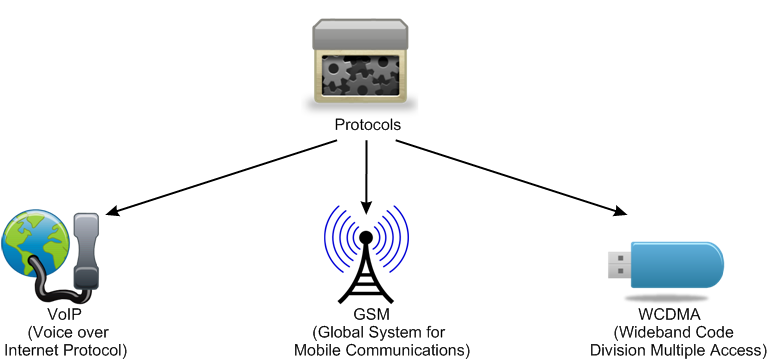GSM vs. WCDMA vs. VoIP
This article discusses three different kinds of protocols: GSM, WCDMA and VoIP that describe the communication in relation with mobile phones. In the sections below you can get know what they do and how they work. It is worth reading the article because you will be familiar with the protocols that are key elements in the communication process.
Definitions of the Protocols
(Figure 1)VoIP (Voice over Internt Protocol) is an innovative technology that makes it possible to make phone calls to computers or other phones over the Internet.
GSM (Global System for Mobile Communications) is a protocol that was created by the European Telecommunications Standards Intitute (ETSI) to describe different protocols for 2G (second generaion) mobile phones.
WCDMA (Wideband Code Division Multiple Access) is also a standard/ a protocol, that is applied in 3G (third generation) mobile phones.

About VoIP
VoIP transfers the data without delay becaue it is a real-time technology. This technology allows you to make telephone calls from a VoIP phone or even from a computer via the Internet. An adapter is needed for a VoIP phone to establish the connection to VoIP service. Computers need software installed on them to be able to initiate calls through a VoIP channel.
The Voice over Internet Protocol service has lots of features such as showing caller ID, voicemails, call forwarding, last number re-dial, changing phone number, area code selection, call waiting, contact lists, return call, caller ID blocking, do not disturb and so on. These features are free to use and if you want to add extra services, you only need a fast and stable Internet connection. If you make VoIP calls, they are billed per month which is a comfortable solution.
Making VoIP calls requires a PC, an adapter, a special VoIP phone and broadband Internet connection as well.
About GSM
GSM is a telecommunication standard. GSM applies different audio codecs to squeeze 3.1 kHz audio data between 6.5 Kbit/s and 13Kbit/s. The protocol used two codecs that are named after the data channels: Half Rate and Full rate that work with different data transmission speed. Later, another codec was developed, the Enhanced Full Rate codec.
Half Rate codec - also spelled HR, GSM-HR or GSM 06.20 - is a speech coding system that operates at 6.5 Kbit/s.
Full Rate codec (FR, GSM FR, GSM 06.10) is also a speech coding standard but it was used first. Therefore it cannot provide great voice quality.
The Enhanced Full Rate codec (GSM 06.60) is an improved version of FR codec therefore it can provide a better voice quality.
About WCDMA
WCDMA is a channel between a mobile extension and a base station and this channel is radio-based. It is a protocol that is used in third generation (3G) mobile networks. For having high speed and more support for users, the protocol uses the so-called DS-CDMA (Direct Sequence) transmission technique and the FDD (Feature-driven Development) duplexing method.
WCDMA employs the same network as second generation (2G) GSM networks. This enables mobile phones to operate in dual mode: mobile telephones can work with more networks or forms of data transmission. The protocol transmits on two 5MHz radio channels. WCDMA describes the communication between a mobile telephone and a tower, how signals are modulated and also how datagrams are built up.
3G mobile telephones have the ability to connect to the Internet and if the phones have Internet connection you are able to connect them to Ozeki Phone System. Once there is Internet connection available, mobile phones can make VoIP calls through Ozeki Phone System with the help of a VoIP provider.
Read the following pages related to the protocols:
- SIP Protocol explained
- RTP Protocol explained
- H.323 Protocol explained
- What is VoIP?
- What is VoIP Phone?
More information
- H.323 vs. SIP
- FXO vs. FXS
- ISDN NT vs. ISDN TE
- ISDN NT1 vs. ISDN NT
- E1 vs. T1 vs. J1
- ISDN BRI vs. PRI
- GSM vs. WCDMA vs. VoIP
- RTP vs. SIP
- VoIP UDP vs. VoIP TCP
- Linux PBX vs. Ozeki PBX
- Other PBX vs. Ozeki PBX
- Cisco Call Manager vs. Ozeki PBX
- How Ozeki PBX Works With Microsoft Software Products
- Trixbox vs. Ozeki PBX
- Elastix vs. Ozeki PBX
- PSTN vs. VoIP
- Hosted PBX vs. PBX on LAN
- IPhone vs. Windows Mobile VoIP Calls
- Android vs. Windows Mobile VoIP Calls
- IPhone vs. Android VoIP Calls
- VoIP vs. GSM
- VLAN vs. Trunks
- Fring vs. VoIP
- Skype vs. VoIP

 Sign in
Sign in